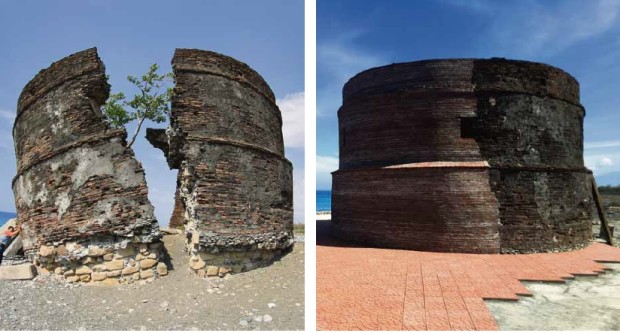
REHAB FUSION The restored Baluarte looks like a fusion of old and new: a grizzled gray half of the tower that is wedded to a new section that has a light concrete-gray color. —EV ESPIRITU/JOEL RILLORAZA/LUNAASSISTANT TOURISMOFFICER
SAN FERNANDO CITY—The 400-year-old watchtower, known to residents and tourists in the coastal town of Luna in La Union province as “Baluarte” (fortress), is whole again.
Half of the 5.6-meter high Spanish-era structure collapsed due to strong waves generated by Typhoon “Lando” (international name: Koppu) in October 2015.
The typhoon left the other half standing but waves and strong winds washed fragments of the debris toward the sea.
Government historians and conservation experts oversaw repairs on the tower, working hard to approximate the structure’s architectural design and materials.
The restored Baluarte looks like a fusion of old and new: a grizzled gray half of the tower that is wedded to a new section that has a light concrete-gray color.
Baluarte served as a fortress used by the Spaniards, who posted sentries tasked with scanning the sea for pirates and alert the community.
It stands on the scenic beach of Barangay Victoria, which is covered with stones of different colors and shapes.
Half-eroded
“When half of Baluarte eroded, with chunks of the debris lying on the beach, the number of tourists coming to the town was cut in half, too,” said Luna Mayor Victor Maron.
Baluarte was classified as a national treasure in 2014, which enabled the National Museum of the Philippines (NMP) to allocate funds for its restoration, said Tito Gorospe, Luna’s tourism officer.
The restoration was started in October 2016 and completed in the last week of January, with the Department of Public Works and Highways and the La Union provincial government’s engineering office working together on the project.
Like almost all Spanish structures, Baluarte was made of adobe and coral blocks held together with lime and egg white.
Fabricated adobe bricks
The local government used adobe bricks to reconstruct the structure’s fallen section. The construction materials were fabricated in the town, copying the original look of Baluarte.
Gorospe said P5 million from the NMP fund was used for the restoration, including the construction of a stable foundation against strong waves.
Another P5 million from NMP was used to build a breakwater to protect Baluarte from storm surges.
Landmark destination
Maron said grills had been installed to prevent entry although visitors could still catch a glimpse of the interior of this Spanish structure.
Its surroundings have been paved and topped with adobe bricks to serve as an area for the community’s social activities, Maron said.
Baluarte remains the town’s landmark tourist attraction and the municipal government has proposed to build a baywalk, toilets and food hubs around it.
“The watchtower is back … [so] we are back on the tourism map,” Maron said.